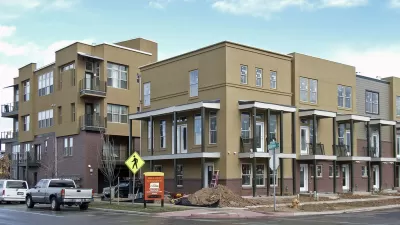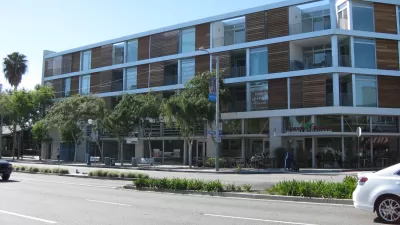Is a $50,000 annual income wealth or poverty in North America? By historical or international standards such an income should be considered wealthy and luxurious, but most people I know consider it poverty because of the high cost of living.
Is a $50,000 annual income wealth or poverty in North America? By historical or international standards such an income should be considered wealthy and luxurious, but most people I know consider it poverty because of the high cost of living.
We have become inefficient at satisfying basic needs, in part due to automobile dependency and sprawl. As a result, owning a car is a necessity and affordable but comfortable housing in short supply, ratcheting up the cost of living. The problems of unaffordability are likely to become worse: Rising unemployment and declining investment returns are causing many households to face new and sometimes severe financial problems.
Unaffordability is generally categorized as a "social" problem, but it is also an "economic" problem that constrains economic development. Improving affordability in a community should be as important to a chamber of commerce and economic development agency as to a welfare agency or charity.
Low- and medium-wage jobs are an important economic input, representing 20-50% of total jobs. Even high wage industries require numerous lower-wage support employees. For example, physicians, lawyers and business executives require receptionists, technicians and cleaners. If a community has a high cost of living, businesses may have difficulty filling positions, be forced to pay higher wages, have higher turnover, and more employees working multiple jobs, reducing their availability and work quality. Workers may be forced to commute long distances in old cars, leading to stress and unreliability. Some potential workers may stay on social assistance rather than move to areas with more jobs but high living costs. High cost of living may reduce the number of college and university students, retirees, artists and innovators moving to a community, reducing growth in associated industries.
High transportation and housing costs that increase the cost of living in a community drive up wages to attract a given quality of employee. For example, if basic transportation and housing costs are $300 per month higher than other communities, local employers must pay an extra $1.88 per hour. If these costs are $700 per month higher, employers must pay an extra $4.38 per hour.
Not all employees are equally affected by inaffordability. Some pay no rent because they live with family, own their homes or have subsidized housing. Some may accept inferior housing in exchange for a better quality of life or long-term economic opportunities. But once this pool is tapped businesses must pay higher wages to attract additional employees. The result is less economic activity and lower profits than would occur with more affordable transportation and housing. This suggests that policies and programs that increase transportation and housing affordability support economic development, particularly in rapid growth communities that wish to expand industries that rely significantly on low- and medium-based employees, or to attract students, retirees, artists and other innovators.
There are many ways communities can improve affordability, but some are much better than others overall because they increase transportation system and land use efficiency, and so help achieve other planning objectives such as reducing traffic congestion, accidents, energy dependence and pollution emissions:
· Improve affordable transport modes such as walking, cycling and public transit. People who live in more multi-modal communities tend to spend 10-30% less on transportation than residents of more automobile-dependent communities.
· Reduce residential parking requirements, particularly for lower-priced housing located in accessible, multi-modal areas. Current zoning code parking requirements are excessive in general, and are particularly harmful to lower-income households which tend to own fewer than average vehicles and value the opportunity to save money from reduced parking costs.
· Make occasional automobile transport more affordable with Pay-As-You-Drive vehicle insurance and registration fees, Carsharing and Taxi Service improvements.
· Implement Location Efficient development policies, so more development occurs in accessible locations, particularly affordable housing.
· Implement Smart Growth policy reforms, which help create more accessible, compact, multi-modal communities with more diverse and affordable housing options.
For more information on these issues see:
CNT (2006), Paved Over: Surface Parking Lots or Opportunities for Tax-Generating, Sustainable Development?, Center for Neighborhood Technology (www.cnt.org/repository/PavedOver-Final.pdf).
CNT (2008), Housing + Transportation Affordability Index, Center for Neighborhood Technology (http://htaindex.cnt.org).
FTA (2008), Better Coordination of Transportation and Housing Programs to Promote Affordable Housing Near Transit, Federal Transit Administration, USDOT and Department of Housing and Urban Development; at www.huduser.org/Publications/pdf/better_coordination.pdf.
HUD (2008), "Parking Regulations and Housing Affordability," Regulatory Barriers Clearinghouse, Volume 7, Issue 2, US Department of Housing and Urban Development, (www.huduser.org); at www.huduser.org/rbc/newsletter/vol7iss2more.html.
Marc Lee, Erick Villagomez, Penny Gurstein, David Eby and Elvin Wyly (2008), Affordable EcoDensity: Making Affordable Housing a Core Principle of Vancouver's EcoDensity Charter, Canadian Center for Policy Alternatives (www.policyalternatives.ca); at www.policyalternatives.ca/documents/BC_Office_Pubs/bc_2008/affordable_ecodensity.pdf.
Barbara Lipman (2006), A Heavy Load: The Combined Housing and Transportation Burdens of Working Families, Center for Housing Policy (www.nhc.org/pdf/pub_heavy_load_10_06.pdf).
Todd Litman (2003), Parking Requirement Impacts on Housing Affordability, VTPI (www.vtpi.org); at www.vtpi.org/park-hou.pdf.
Todd Litman (2004a), Pay-As-You-Drive Pricing For Insurance Affordability, VTPI (www.vtpi.org); at www.vtpi.org/payd_aff.pdf.
Todd Litman (2007), Transportation Affordability: Evaluation and Improvement Strategies, VTPI (www.vtpi.org); at www.vtpi.org/affordability.pdf.
ULI (2009), Beltway Burden: The Combined Cost of Housing and Transportation in the Greater Washington, DC Metropolitan Area, ULI Terwilliger Center for Workforce Housing, Urban Land Institute (www.uli.org); at http://commerce.uli.org/misc/BeltwayBurden.pdf).

Study: Maui’s Plan to Convert Vacation Rentals to Long-Term Housing Could Cause Nearly $1 Billion Economic Loss
The plan would reduce visitor accommodation by 25,% resulting in 1,900 jobs lost.

North Texas Transit Leaders Tout Benefits of TOD for Growing Region
At a summit focused on transit-oriented development, policymakers discussed how North Texas’ expanded light rail system can serve as a tool for economic growth.

Why Should We Subsidize Public Transportation?
Many public transit agencies face financial stress due to rising costs, declining fare revenue, and declining subsidies. Transit advocates must provide a strong business case for increasing public transit funding.

How to Make US Trains Faster
Changes to boarding platforms and a switch to electric trains could improve U.S. passenger rail service without the added cost of high-speed rail.

Columbia’s Revitalized ‘Loop’ Is a Hub for Local Entrepreneurs
A focus on small businesses is helping a commercial corridor in Columbia, Missouri thrive.

Invasive Insect Threatens Minnesota’s Ash Forests
The Emerald Ash Borer is a rapidly spreading invasive pest threatening Minnesota’s ash trees, and homeowners are encouraged to plant diverse replacement species, avoid moving ash firewood, and monitor for signs of infestation.
Urban Design for Planners 1: Software Tools
This six-course series explores essential urban design concepts using open source software and equips planners with the tools they need to participate fully in the urban design process.
Planning for Universal Design
Learn the tools for implementing Universal Design in planning regulations.
City of Santa Clarita
Ascent Environmental
Institute for Housing and Urban Development Studies (IHS)
City of Grandview
Harvard GSD Executive Education
Toledo-Lucas County Plan Commissions
Salt Lake City
NYU Wagner Graduate School of Public Service






























